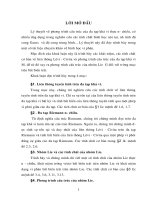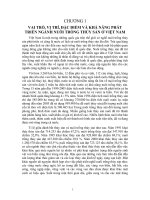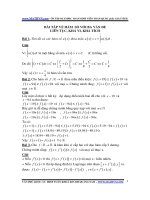- Trang chủ >>
- Đề thi >>
- Đề thi lớp 6
Kha vi Gato
Bạn đang xem bản rút gọn của tài liệu. Xem và tải ngay bản đầy đủ của tài liệu tại đây (182.28 KB, 6 trang )
<span class='text_page_counter'>(1)</span><div class='page_container' data-page=1>
<b>Gâteaux derivative</b>
In mathematics, the Gâteaux differential or Gâteaux derivative is a generalization of the concept of directional
derivative in differential calculus. Named after René Gâteaux, a French mathematician who died young in World
War I, it is defined for functions between locally convex topological vector spaces such as Banach spaces. Like the
Fréchet derivative on a Banach space, the Gâteaux differential is often used to formalize the functional derivative
commonly used in the calculus of variations and physics.
Unlike other forms of derivatives, the Gâteaux differential of a function may be nonlinear. However, often the
definition of the Gâteaux differential also requires that it be a continuous linear transformation. Some authors, such
as Tikhomirov (2001), draw a further distinction between the Gâteaux differential (which may be nonlinear) and the
Gâteaux derivative (which they take to be linear). In most applications, continuous linearity follows from some more
primitive condition which is natural to the particular setting, such as imposing complex differentiability in the
context of infinite dimensional holomorphy or continuous differentiability in nonlinear analysis.
<b>Definition</b>
Suppose X and Y are locally convex topological vector spaces (for example, Banach spaces), U ⊂ X is open, and
<i>F : X </i>→ Y. The Gâteaux differential dF(u;ψ) of F at u ∈ U in the direction ψ ∈ X is defined as
<b>(</b>1<b>)</b>
if the limit exists. If the limit exists for all ψ ∈ X, then one says that F is Gâteaux differentiable at u.
The limit appearing in (1) is taken relative to the topology of Y. If X and Y are real topological vector spaces, then the
limit is taken for real τ. On the other hand, if X and Y are complex topological vector spaces, then the limit above is
usually taken as τ→0 in the complex plane as in the definition of complex differentiability. In some cases, a weak
limit is taken instead of a strong limit, which leads to the notion of a weak Gâteaux derivative.
<b>Linearity and continuity</b>
At each point u ∈ U, the Gâteaux differential defines a function
This function is homogeneous in the sense that for all scalars α
However, this function need not be additive, so that the Gâteaux differential may fail to be linear, unlike the Fréchet
derivative. Even if linear, it may fail to depend continuously on ψ if X and Y are infinite dimensional. Furthermore,
for Gâteaux differentials that are linear and continuous in ψ, there are several inequivalent ways to formulate their
continuous differentiability.
For example, consider the real-valued function F of two real variables defined by
</div>
<span class='text_page_counter'>(2)</span><div class='page_container' data-page=2>
However this is continuous but not linear in the arguments (a,b). In infinite dimensions, any discontinuous linear
functional on X is Gâteaux differentiable, but its Gâteaux differential at 0 is linear but not continuous.
Relation with the Fréchet derivative
If F is Fréchet differentiable, then it is also Gâteaux differentiable, and its Fréchet and Gâteaux derivatives agree.
The converse is clearly not true, since the Gâteaux derivative may fail to be linear or continuous. In fact, it is even
possible for the Gâteaux derivative to be linear and continuous but for the Fréchet derivative to fail to exist.
Nevertheless, for functions F from a complex Banach space X to another complex Banach space Y, the Gâteaux
derivative (where the limit is taken over complex τ tending to zero as in the definition of complex differentiability) is
automatically linear, a theorem of Zorn (1945). Furthermore, if F is (complex) Gâteaux differentiable at each u ∈ <i>U</i>
with derivative
then F is Fréchet differentiable on U with Fréchet derivative DF (Zorn 1946). This is analogous to the result from
basic complex analysis that a function is analytic if it is complex differentiable in an open set, and is a fundamental
result in the study of infinite dimensional holomorphy.
Continuous differentiability
Continuous Gâteaux differentiability may be defined in two inequivalent ways. Suppose that F:U→<i>Y is Gâteaux</i>
differentiable at each point of the open set U. One notion of continuous differentiability in U requires that the
mapping on the product space
be continuous. Linearity need not be assumed: if X and Y are Fréchet spaces, then dF(u;•) is automatically bounded
and linear for all u (Hamilton 1982).
A stronger notion of continuous differentiability requires that
be a continuous mapping
from U to the space of continuous linear functions from X to Y. Note that this already presupposes the linearity of
<i>DF(u).</i>
As a matter of technical convenience, this latter notion of continuous differentiability is typical (but not universal)
when the spaces X and Y are Banach, since L(X,Y) is also Banach and standard results from functional analysis can
then be employed. The former is the more common definition in areas of nonlinear analysis where the function
spaces involved are not necessarily Banach spaces. For instance, differentiation in Fréchet spaces has applications
such as the Nash–Moser inverse function theorem in which the function spaces of interest often consist of smooth
functions on a manifold.
<b>Higher derivatives</b>
Whereas higher order Fréchet derivatives are naturally defined as multilinear functions by iteration, using the
isomorphisms Ln(X,Y) = L(X, Ln−1(X,Y)), higher order Gâteaux derivative cannot be defined in this way. Instead the
<i>nth order Gâteaux derivative of a function F : U</i>⊂<i>X </i>→ Y in the direction h is defined by
<b>(</b>2<b>)</b>
</div>
<span class='text_page_counter'>(3)</span><div class='page_container' data-page=3>
<b>(</b>3<b>)</b>
that arises naturally in the calculus of variations as the second variation of F, at least in the special case where F is
scalar-valued. However, this may fail to have any reasonable properties at all, aside from being separately
homogeneous in h and k. It is desirable to have sufficient conditions in place to ensure that D2<i>F(u){h,k} is a</i>
symmetric bilinear function of h and k, and that it agrees with the polarization of dnF.
For instance, the following sufficient condition holds (Hamilton 1982). Suppose that F is C1 in the sense that the
mapping
is continuous in the product topology, and moreover that the second derivative defined by (3) is also continuous in
the sense that
is continuous. Then D2<i>F(u){h,k} is bilinear and symmetric in h and k. By virtue of the bilinearity, the polarization</i>
identity holds
relating the second order derivative D2<i>F(u) with the differential d</i>2<i>F(u;</i>−). Similar conclusions hold for higher order
derivatives.
<b>Properties</b>
A version of the fundamental theorem of calculus holds for the Gâteaux derivative of F, provided F is assumed to be
sufficiently continuously differentiable. Specifically:
• Suppose that F : X → <i>Y is C</i>1 in the sense that the Gâteaux derivative is a continuous function dF : U×X→<i>Y. Then</i>
for any u∈<i>U and h</i>∈<i>X,</i>
where the integral is the Gelfand-Pettis integral (the weak integral).
Many of the other familiar properties of the derivative follow from this, such as multilinearity and commutativity of
the higher-order derivatives. Further properties, also consequences of the fundamental theorem, include:
• (The chain rule.)
for all u ∈ <i>U and x </i>∈ <i>X.</i>
• (Taylor's theorem with remainder.)
Suppose that the line segment between u ∈ <i>U and u+h lies entirely within U. If F is C</i>k then
</div>
<span class='text_page_counter'>(4)</span><div class='page_container' data-page=4>
<b>Example</b>
Let be the Hilbert space of square-integrable functions on a Lebesgue measurable set in the Euclidean space
<b>RN. The functional</b>
given by
where F is a real-valued function of a real variable with F′ = ƒ and u is defined on Ω with real values, has Gâteaux
derivative
Indeed,
Letting τ → 0 gives the Gâteaux derivative
that is, the inner product 〈ƒ,ψ〉.
<b>References</b>
• Gâteaux, R (1913), "Sur les fonctionnelles continues et les fonctionnelles analytiques" [1], Comptes rendus de
<i>l'academie des sciences (Paris) 157: 325</i>–327, retrieved 30 July 2006.
• Gâteaux, R (1919), "Fonctions d'une infinité de variables indépendantes" [2], Bulletin de la Société Mathématique
<i>de France 47: 70</i>–96.
• Hamilton, R. S. (1982), "The inverse function theorem of Nash and Moser" [3], Bull. AMS. 7 (1): 65–222,
doi:10.1090/S0273-0979-1982-15004-2, MR656198
• Hille, Einar; Phillips, Ralph S. (1974), Functional analysis and semi-groups, Providence, R.I.: American
Mathematical Society, MR0423094.
• Tikhomirov, V.M. (2001), "Gâteaux variation" [4], in Hazewinkel, Michiel, Encyclopedia of Mathematics,
Springer, ISBN 978-1-55608-010-4.
• Zorn, Max (1945), "Characterization of analytic functions in Banach spaces", Annals of Mathematics. Second
<i>Series 46 (4): 585</i>–593, doi:10.2307/1969198, ISSN 0003-486X, JSTOR 1969198, MR0014190.
</div>
<span class='text_page_counter'>(5)</span><div class='page_container' data-page=5>
<b>References</b>
[1] />
[2] :80/numdam-bin/item?id=BSMF_1919__47__70_1
[3] />
[4] />
</div>
<span class='text_page_counter'>(6)</span><div class='page_container' data-page=6>
<b>Article Sources and Contributors</b>
<b>Gâteaux derivative </b><i>Source</i>: <i>Contributors</i>: Bernhard Neubüser, Charles Matthews, David Sneek, Debresser, Diegotorquemada, Drilnoth,
Foobarnix, Gaius Cornelius, Garygateaux, Gene Nygaard, Giftlite, Holger Blasum, Konradek, Kupirijo, Lethe, Linas, Michael Hardy, Netrapt, Oleg Alexandrov, Rich Farmbrough, Sergey
Dmitriev, Sethead, Silly rabbit, Stevvers, Sławomir Biały, Tong, WLior, Wkister, Xiner, Yakiv Gluck, 17 anonymous edits
<b>License</b>
</div>
<!--links-->
<a href=' /><a href=' />









